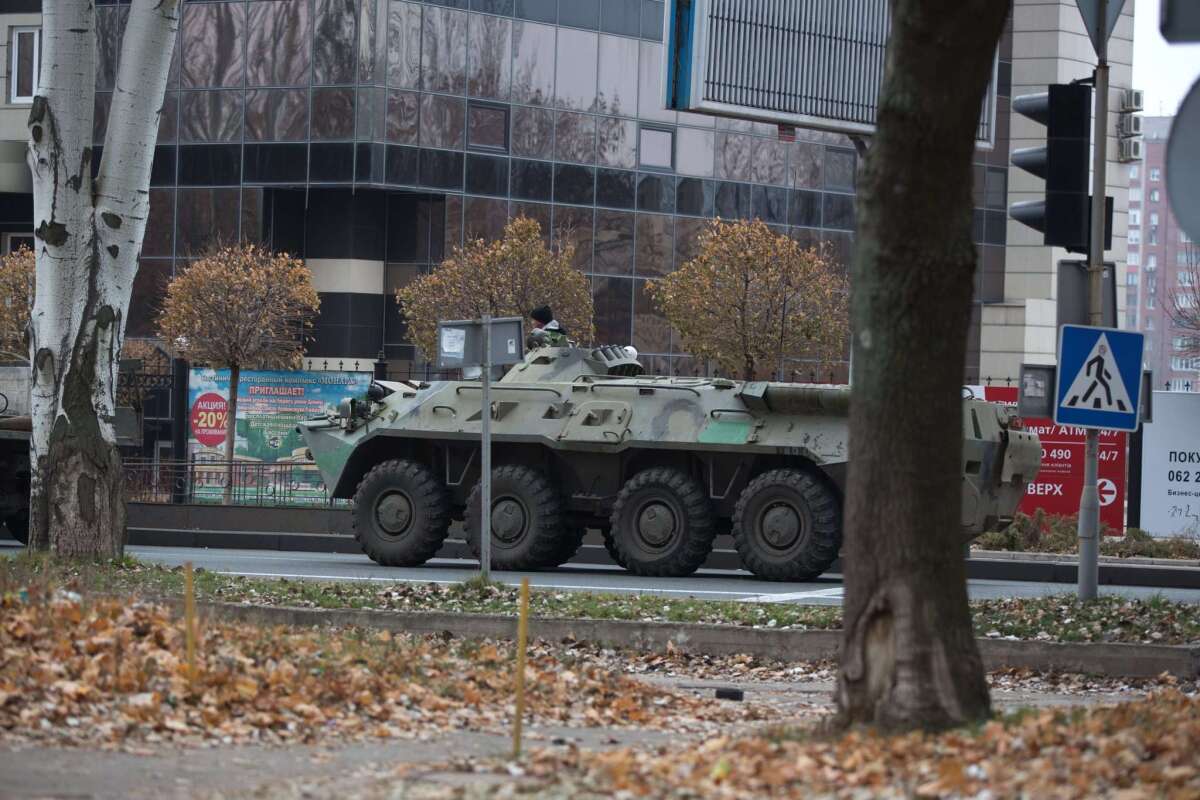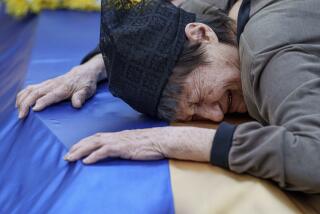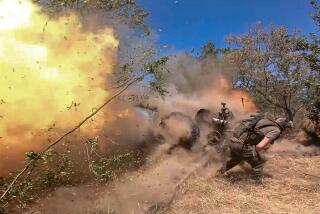Columns of Russian armor and troops entering Ukraine, NATO says

- Share via
Moscow’s tension with the West sharpened Wednesday with NATO’s top commander saying the alliance has seen Russian armored columns entering eastern Ukraine in recent days and Russia’s defense minister announcing resumption of Cold War-era bomber patrols off U.S. shores.
U.S. Gen. Philip Breedlove told reporters during a visit to Bulgaria that the border between Ukraine and Russia where Moscow-backed separatists are in control is now “completely wide open” to infusions of foreign fighting power into the conflict area.
“We have seen columns of Russian equipment, primarily Russian tanks, Russian artillery, Russian air-defense systems and Russian combat troops entering Ukraine,” Breedlove said.
He said the North Atlantic Treaty Organization didn’t have a firm number on the invading vehicles but said they were in “multiple columns.”
“Forces, money, support, supplies, weapons are flowing back and forth across this border completely at will and that is not a good situation,” Breedlove said.
Russia’s Defense Ministry called the NATO allegations “completely untrue,” the Tass news agency reported.
At a meeting of Russia’s national defense council in Moscow, Defense Minister Sergei Shoigu announced that the Kremlin’s long-range bombers would resume patrolling the western Atlantic and eastern Pacific, including the Caribbean and Gulf of Mexico. The patrols mostly ceased, for budget reasons, after the 1991 breakup of the Soviet Union.
“This is connected to the situation in Ukraine, with the emerging anti-Russia inclinations on the part of NATO and the increasing foreign military presence in the immediate vicinity of our borders,” Shoigu said in remarks posted on the ministry’s website.
Shoigu said conditions in Ukraine “dictate the necessity to maintain readiness of troops” in Russia’s Southern Military District, which borders eastern Ukraine, and that Crimea would be reinforced with “full-fledged and self-sufficient” defense capabilities.
Russian troops seized Ukraine’s Crimean peninsula, where Russia’s Black Sea fleet is based, after a pro-Europe rebellion in western Ukraine ousted Kremlin-allied President Viktor Yanukovich in February. Russia’s annexation of Crimea on March 16 sparked separatist actions elsewhere in eastern Ukraine that have taken more than 4,000 lives since April.
The resumption of long-range patrols was hinted at this year, when Shoigu said Russia was negotiating with allies in Latin America and Asia for potential use of their bases and maintenance facilities. The defense chief mentioned at the time talks underway with Soviet-era military allies in Cuba, Nicaragua, Venezuela and Vietnam.
In the eight months since the Crimea seizure, the Kremlin’s air force has been conducting what European monitors see as provocative forays near and, at times, over the borders of its neighbors. On Monday, the London-based European Leadership Network reported a sharp increase in Russian air operations that have violated other countries’ airspace, risked collisions, buzzed NATO and Ukrainian warships and staged mock bombing runs.
Breedlove, in his comments in Sofia, Bulgaria’s capital, said NATO’s recent sightings of Russian arms and troops entering Ukraine confirmed reports by the Organization for Security and Cooperation in Europe of at least three columns of tanks, armored vehicles and trucks towing howitzers and multiple-rocket launchers. Gunmen in green uniforms without insignia also were reported to be flooding into the front-line areas from the east.
In Kiev, the Ukrainian capital, Defense Minister Stepan Poltorak said at a Cabinet meeting Wednesday that reservists had been called up, the military was aware of the Russian invaders’ positions and that the main task for Ukraine’s armed forces now is “to prepare for fighting.”
The buildups on both sides of the conflict were the latest and most ominous signs that a relative lull in fighting that followed a Sept. 5 cease-fire agreement has ended and an intensified phase is looming.
The U.N. and European and other Western governments lambasted Russia for supporting Nov. 2 elections staged by the pro-Moscow separatists occupying Ukraine’s Donetsk and Luhansk regions, which purported to empower government and legislative leaders for what they contend are independent republics.
On Wednesday, Russian Foreign Minister Sergei Lavrov spoke by telephone with U.S. Secretary of State John F. Kerry and advised him to persuade Ukraine’s government to deal directly with the separatist leaders to put an end to the deadly conflict, the Tass news agency reported.
“When exchanging opinions on the current situation in Ukraine’s southeast, Lavrov specially underlined that organizing stable direct dialogue between Kiev and Luhansk and Donetsk is a priority in the context of elections held there,” Tass said of the conversation with Kerry.
Although no country has recognized the May independence declarations of the two “people’s republics,” the Russian Foreign Ministry said after the votes that Moscow “respects the will expression of the residents of the southeast,” in effect recognizing the rogue leaders as legitimate representatives of the breakaway regions.
Follow @cjwilliamslat for the latest international news 24/7
More to Read
Sign up for Essential California
The most important California stories and recommendations in your inbox every morning.
You may occasionally receive promotional content from the Los Angeles Times.














